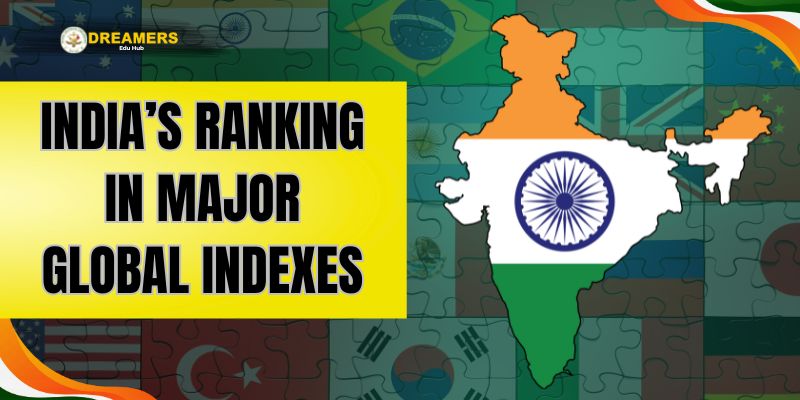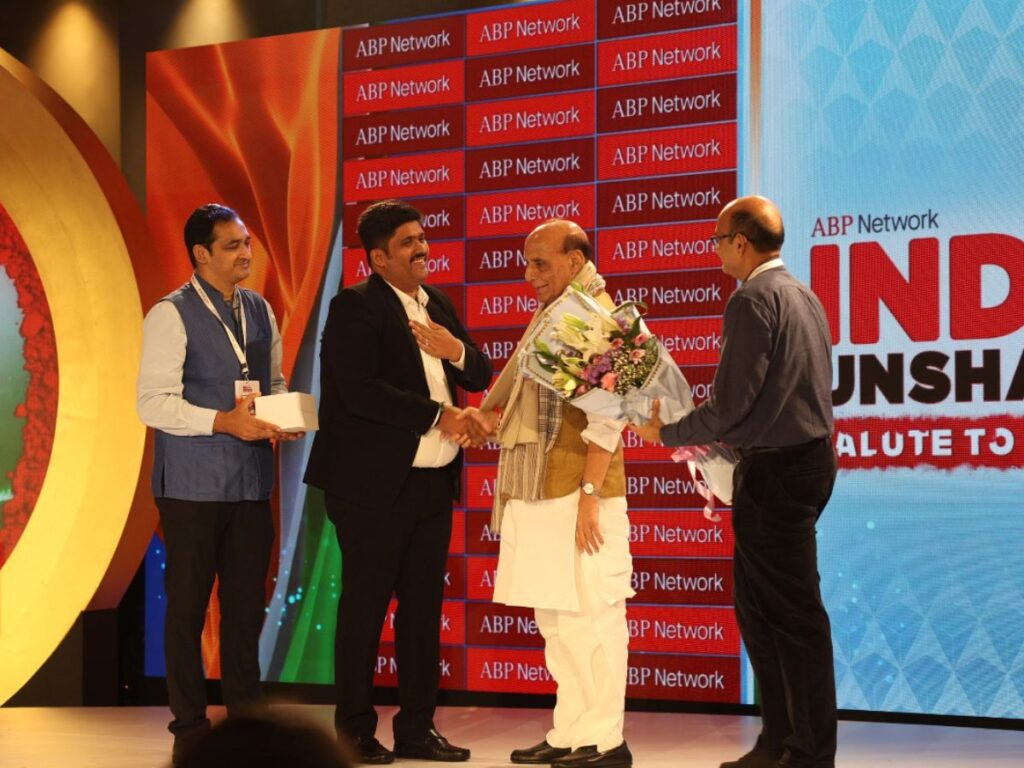Introduction – How does the world measure India?
Today, every major international institution publishes report-card-style lists of countries –
some measure human development, some hunger, some corruption, some press freedom, and some climate action.
These report cards are what we call Global Indexes.
From these indexes we understand:
- Where India stands in terms of human development
- What our hunger / nutrition situation is like
- What our level is in gender equality, democracy, press freedom, corruption, peace, innovation, environment and climate
- And whether India is moving up or falling behind compared to other countries
Below you will find the most important Global Indexes related to India, the institutions that publish them, and India’s latest rank in each – all in one place, so this content can be directly used in blogs / notes / current affairs and give the reader a clear picture.
What is a Global Index?
Generally, there are four common steps behind any Global Index:
1. Choosing Indicators
For example, for HDI – life expectancy, education, per capita income etc.
2. Collecting Data
From UN agencies, World Bank, IMF, government statistics, large surveys, research papers, etc.
3. Building a Score
Different indicators are brought onto a common scale (like 0–1 or 0–100), given weights, and then combined into one overall score.
4. Deciding the Rank
All countries are then arranged from highest to lowest according to this score –
that order becomes their rank.
That’s why sometimes it happens that India’s score improves slightly, but
other countries improve much faster –
so India’s rank looks lower, even though the ground situation has actually improved a bit.
India at a Glance – India’s Rank in the Most Important Global Indexes
(Latest available report / year, up to 2025)
| Area / Theme | Name of Index | India’s Latest Rank* | Total Countries | Who publishes it? |
|---|---|---|---|---|
| Human Development | Human Development Index (HDI) 2023 | 130 / 193 | 193 | UNDP |
| Hunger & Malnutrition | Global Hunger Index (GHI) 2025 | 102 / 123 | 123 | Concern & Welthungerhilfe |
| Gender Equality | Global Gender Gap Index 2025 | 131 / 148 | 148 | World Economic Forum |
| SDGs Progress | SDG Index 2025 | 99 / 167 | 167 | SDSN / UN Network |
| Press Freedom | World Press Freedom Index 2025 | 151 / 180 | 180 | RSF |
| Peace & Violence | Global Peace Index 2024–25 | around 115–116 / 163 | 163 | IEP |
| Corruption Perception | Corruption Perceptions Index 2023 | 93 / 180 (score 39/100) | 180 | Transparency International |
| Quality of Democracy | Democracy Index 2023 | 41 / 167, Category – Flawed Democracy | 167 | Economist Intelligence Unit |
| Innovation & Technology | Global Innovation Index (GII) 2025 | 38 / 139 | 139 | WIPO + INSEAD |
| Logistics / Trade | Logistics Performance Index (LPI) 2023 | 38 / 139 | 139 | World Bank |
| Environmental Performance | Environmental Performance Index (EPI) 2022–24 | 180 / 180 in 2022, 176 / 180 in 2024 | 180 | Yale & Columbia |
| Climate Action | Climate Change Performance Index (CCPI) 2025 | around 10 / 63 | ~63 | Germanwatch + CAN |
| Talent & Skill Ecosystem | IMD World Talent Ranking 2025 | 63 / 67+ | 67+ | IMD Business School |
| Talent Competitiveness | Global Talent Competitiveness Index 2023 | 103 / 134 | 134 | INSEAD + Portulans |
| Global Competitiveness (old) | Global Competitiveness Index 2019 | 68 / 141 | 141 | World Economic Forum |
| Economy & Competitiveness | IMD World Competitiveness Ranking 2025 | 41 / 69 | 69 | IMD Business School (Lausanne, Switzerland) |
| Energy Transition | Energy Transition Index (ETI) 2025 | 71 / 118 | 118 | World Economic Forum (WEF) |
| Start-up / Unicorn Ecosystem | Hurun Global Unicorn Index 2025 | 03 / 64 | 64 | Hurun Research Institute (Shanghai-based, Hurun Report) |
| Fish Production | Global Fish Production | 02 / 190 | 190 | Food and Agriculture Organization |
| Travel & Tourism GDP | Global Tourism Economy | 08 / 190 | 190 | World Travel & Tourism Council |
| Impact of Terrorism | Global Terrorism Index (GTI) 2025 | 14 / 163 | 163 | Institute for Economics & Peace (IEP), Sydney – Global Terrorism Index report |
| Happiness / Life Satisfaction | World Happiness Report 2025 | 118 / 147 | 147 | UN Sustainable Development Solutions Network (SDSN) |
* Ranks change slightly with every new report; but for exam and understanding purposes, this is a sufficiently up-to-date picture.
India in Social Development Indexes
Human Development Index (HDI)
What does it measure?
- Life expectancy
- Education (mean and expected years of schooling)
- Per capita GNI (Gross National Income per person)
Who publishes it? – UNDP’s Human Development Report.
India’s position
For 2023, India’s rank is 130 / 193 (earlier it was 133, i.e. an improvement of 3 places).
What does this mean?
Education and income are gradually improving,
but India is still in the Medium Human Development category – there is still a gap with high human-development countries.
Global Hunger Index (GHI) – The reality of hunger
What does it measure?
- Undernourishment
- Wasting (low weight) among children
- Stunting (poor growth)
- Child mortality (under-5 mortality)
Who publishes it? – German NGO Welthungerhilfe and Ireland-based Concern Worldwide together.
India’s position
In GHI 2025, India’s rank is 102 / 123, score 25.8 – category: Serious Hunger.
Special point
The Government of India often questions the methodology of GHI (especially the surveys used for estimating hunger),
yet for competitive exams, the official GHI rank is generally what is asked.
SDG Index – India on the Sustainable Development Goals
What does it measure?
Progress of countries on the 17 Sustainable Development Goals (poverty, health, education, climate, inequality, etc.).
Who publishes it? – Sustainable Development Solutions Network (SDSN) and partner institutions.
India’s position
According to the UN Sustainable Development Report 2024, India’s rank is 109, with a total score of about 64.0.
What does this indicate?
In some areas (like SDG-1 Poverty, SDG-4 Education, SDG-12 Responsible Consumption, SDG-13 Climate) India is showing progress,
but in nutrition, gender equality, environment and inequality, challenges are still significant.
Global Gender Gap Index – The mirror of gender equality
What does it measure?
- Economic participation & opportunity
- Educational attainment
- Health & survival
- Political empowerment
Who publishes it? – World Economic Forum (WEF).
India’s position
According to the Global Gender Gap Report 2025, India’s rank is 131 / 148.
Key point
The score has improved slightly, but other countries are progressing faster,
so India’s ranking appears to slip further down –
especially in women’s labour force participation, pay equality and political representation.
Democracy, Governance and Rights – Political Indexes
World Press Freedom Index – How free is the media?
What does it measure?
Media freedom, safety of journalists, legal environment, media pluralism, transparency, etc.
Who publishes it? – Reporters Without Borders (RSF).
India’s position
In the 2025 report, India’s rank is 151 / 180 (in 2024 it was 159, so the rank has improved slightly).
Main concerns in the report
Limited ownership of big media houses, political pressure,
digital trolling and legal cases being used as pressure tactics on journalists.
Democracy Index – Quality of democracy
What does it measure?
- Electoral process and pluralism
- Functioning of government
- Political participation
- Political culture
- Civil liberties
Who publishes it? – Economist Intelligence Unit (EIU).
India’s position
In Democracy Index 2023, India’s rank is 41 / 167, total score 7.18 / 10, category – Flawed Democracy.
Meaning
The electoral process and political participation are considered strong,
but some questions and challenges are recorded regarding civil liberties and functioning of government.
Corruption Perceptions Index (CPI)
What does it measure?
Perceived corruption in the public sector – based on business and expert surveys.
Who publishes it? – Transparency International.
India’s position
In CPI 2023, India’s rank is 93 / 180, score 39/100 (the score was 40 in 2022).
Interpretation
The closer the score is to 100, the better –
so the perception of corruption in India is still considered quite serious,
though there are some signs that allow hope for gradual improvement.
Global Peace Index – How peaceful is the country?
What does it measure?
Internal and external conflict,
crime and violence,
military expenditure, arms proliferation, internal security, etc.
Who publishes it? – Institute for Economics & Peace (IEP).
India’s position
In GPI 2024, India was around 116th; in the 2025 report the rank is around 115 – i.e. a slight improvement.
Background
Border disputes, internal security challenges and high military spending push the rank down,
while contribution to UN peacekeeping and reduction in violence in some regions are counted as positives.
Economy, Innovation and Trade
Global Innovation Index (GII) – India in innovation
What does it measure?
R&D, patents, start-up ecosystem, education, digital infrastructure, creative outputs, etc.
Who publishes it? – WIPO (World Intellectual Property Organization) + INSEAD and other partners.
India’s position
In GII 2025, India’s rank is 38 / 139, and 1st among lower middle-income countries.
Positive message
In 2015, India’s rank was 81 – so in a decade India has made a long leap forward on the innovation front.
Logistics Performance Index (LPI) – How smoothly does cargo move?
What does it measure?
- Efficiency of customs
- Transport infrastructure
- International shipments
- Logistics quality, tracking and timeliness
Who publishes it? – World Bank.
India’s position
In LPI 2023, India’s rank is 38 / 139.
Indication
The impact of Dedicated Freight Corridors, PM Gati Shakti, multi-modal logistics parks, etc., has begun to appear in global rankings,
but there is still a long way to go compared to developed logistics hubs.
Global Competitiveness Index (GCI) – An old but important snapshot
What does it measure?
Productivity, institutions, infrastructure, macroeconomic stability, health, skills, market size, innovation capability, etc.
Who publishes it? – World Economic Forum.
India’s position (2019 – last full report)
Rank 68 / 141.
Note
After COVID, this index has not been released regularly in the same format,
but the older data still helps us understand India’s structural strengths and weaknesses.
Talent Indexes – Picture of the Skill Ecosystem
IMD World Talent Ranking 2025
Focus: how well a country can attract, develop and retain talent.
India’s rank is 63rd, score around 36.06 – with a slightly downward trend over the past few years.
Global Talent Competitiveness Index (GTCI 2023)
Focus: talent ecosystem, vocational and higher skills, employability, talent attraction, etc.
India’s rank is 103 / 134, the lowest among BRICS countries.
Conclusion
India has a very large human resource base,
but there is more work needed in areas like average skill quality, management talent, labour market flexibility, etc.
Environment and Climate – The most contrasting picture
Environmental Performance Index (EPI)
What does it measure?
- Environmental Health (air quality, water, sanitation etc.)
- Ecosystem Vitality (biodiversity, forests, fisheries, agriculture, climate policy)
Who publishes it? – Yale and Columbia universities (with WEF support).
India’s position
In EPI 2022, India’s rank was 180 / 180 (lowest), score 18.9.
In EPI 2024, the rank is 176 / 180, meaning India is still among the bottom five countries.
Important point
India has strongly objected to the methodology of this index –
arguing that using the same scale for developed and developing countries is not fair.
But for competitive exams, the official rank is what usually appears, so it has to be remembered.
Climate Change Performance Index (CCPI) – India in climate action
What does it measure?
GHG emissions,
renewable energy,
energy use,
climate policy.
Who publishes it? – Germanwatch, Climate Action Network (CAN), NewClimate Institute.
India’s position
In CCPI 2025, India’s rank is 10th, meaning it is still counted among the top performers,
although it has slipped 2 places compared to 2024.
Interesting fact
Often the top 3 positions in CCPI are left vacant –
to send the message that no country is yet fully on a 1.5°C-compatible path.
In such a situation, India’s 10th position is actually considered quite a strong performance.
How does India get these ranks and from which data?
Most indexes use a mix of:
- India’s official statistics (like Census, NFHS, national accounts, government reports) +
- International databases (World Bank, UN agencies) +
- Independent surveys / expert opinions
Many times, there are differences between the Government of India and global index publishers over methodology –
especially on indexes like GHI, EPI, Press Freedom, etc.
But at the practical level:
- Foreign investors
- Global media
- Multilateral agencies
- And competitive exams
all treat these published rankings as reference.
So whether one agrees with the index or not,
understanding the facts and trends behind it is very important for both India’s policy and India’s image.
How should students / aspirants use these indexes?
1. Remember them in clusters
- Social: HDI, GHI, SDG, Gender Gap
- Governance / Democracy: CPI, Press Freedom, Democracy Index, Global Peace
- Economy / Innovation: GII, LPI, Competitiveness, Talent Indexes
- Environment / Climate: EPI, CCPI
2. Fix just three points for each index
- Who publishes it?
- India’s latest rank (approx + year)
- And in one–two words the message, e.g.:
“Strong in Innovation, weak in Environment, better performer in Climate Action”
Such lines help a lot in interviews.
3. Use a balanced tone while answering
Avoid both extremes –
only “India is far behind” or only “India is a superpower”.
A better way to say it:
“India is doing well in innovation and climate action,
but there is still a lot of scope for improvement in hunger, gender equality, environment and press freedom.”
4. For defence / civil services aspirants
In Group Discussions, Lecturettes, Interviews, Essays,
whenever themes like development, governance, climate, economy come up,
adding 2–3 facts and ranks from these global indexes instantly makes the answer look more credible and mature.
Doon Defence Dreamers on the Importance of India’s Ranking in Global Indexes
Doon Defence Dreamers (Best NDA Coaching in Dehradun) believes that India’s global rankings are not just a game of numbers – they are a mirror that shows our country’s real strengths, challenges and future direction. When we understand India’s position in indexes like HDI, Global Hunger Index, Gender Gap, Democracy, Innovation, Environment and Climate, we can clearly see where we are ahead of the world and where a lot of work is still left to be done.
This understanding is essential for every aware citizen, student and defence aspirant. In SSB interviews, GD, Lecturette or any competitive exam, when a candidate is able to explain India’s global rankings with data and balanced thinking, they are not just repeating current affairs – they are demonstrating an understanding of the nation’s direction and policies. Doon Defence Dreamers believes in preparing exactly such aware, responsible and informed future officers – who will not only wear the uniform, but also play an active role in improving India’s global position.
FAQs – Frequently Asked Questions
Q1. What is a Global Index and why is it important?
Ans. A Global Index is like a report card of a country that gives a score and rank based on things like development, hunger, gender, environment, democracy, innovation, corruption, etc. It helps the world see in which areas countries like India are doing well and where they are lagging behind.
Q2. Does a poor rank always mean the ground situation is very bad?
Ans. Not necessarily. Sometimes India’s score improves, but other countries improve even faster, so our rank appears lower. That is why it is important to look not just at the rank, but also at the trend and context.
Q3. Why is India’s rank low in the Human Development Index (HDI)?
Ans. HDI combines health, education and income. India has made good progress in recent years, but:
- Quality education for all,
- Better health services,
- And higher per capita income
are still areas where a lot of work remains to be done. That’s why India is still in the Medium Human Development category.
Q4. Why does the Government of India often object to the Global Hunger Index (GHI)?
Ans. The government argues that some of the data used in GHI (such as survey-based hunger estimates) does not accurately represent Indian reality and that the methodology is weak. However, at the international level, GHI is still widely used as a reference, and so the GHI rank is what is usually asked in exams.
Q5. Is India really ahead in innovation and start-ups?
Ans. Yes. India’s rank in the Global Innovation Index has improved significantly over the years and India ranks at the top among lower middle-income countries. In terms of the number of unicorns, India stands at third place in the world. This means India’s performance in start-ups, IT, digital public infrastructure and R&D is considered strong.





























